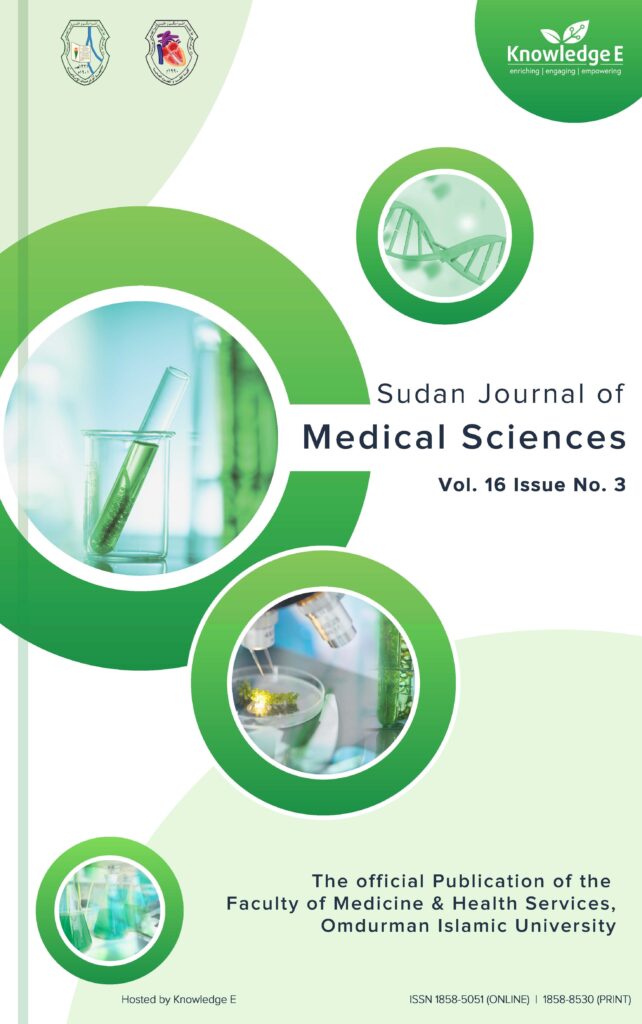
Sudan Journal of Medical Sciences
ISSN: 1858-5051
High-impact research on the latest developments in medicine and healthcare across MENA and Africa
Unexpected Diagnosis of Complete Androgen Insensitivity Syndrome (CAIS) During Inguinal Hernia Repair in 11-year-old-girl
Published date: Mar 31 2021
Journal Title: Sudan Journal of Medical Sciences
Issue title: Sudan JMS: Volume 16 (2021), Issue No. 1
Pages: 70 - 75
Authors:
Abstract:
Complete Androgen Insensitivity Syndrome (CAIS) is an X-link recessive genetic mutation of androgen receptor (AR) gene leading to complete inability of cell to respond to the androgens. CAIS occurs in 1 out of 20,400 XY live-birth babies, and affects about 1–2% of prepubertal girls that present with an inguinal hernia. Although individuals with CAIS have XY, those with grades 6 and 7 on the Quigley scale are born phenotypically female, without any signs of genital masculinization. Thus, individuals affected by CAIS develop a normal external female phenotype with normal female external genitalia, well-developed breast, absent uterus, and bilateral undescended testicles. The question of CAIS diagnosis does not come forward until the absent menses at the puberty is noted or accidentally during an inguinal hernia repair in a premenarchal girl. The present study reports a case of inguinal hernia repair on 11-year-old girl, which led to unexpected intraoperative notion of CAIS. The diagnostic work-up, genetic counseling, sex assignment, and the need for preoperative CAIS screening in girls with bilateral inguinal hernia are described and discussed.
Keywords: DSD, CAIS, bilateral inguinal hernia, gonadectomy
References:
Lubahn, D. B., Joseph, D. R., Sullivan, P. M., et al. (1988). Cloning of human androgen receptor complementary DNA and localization to the X chromosome. Science, vol. 240, no. 4850, pp. 327–330.
[2] Sharma, S., Balwan, W. K., Kumar, P., et al. (2012). Androgen insensitivity syndrome (testicular feminization). Journal of Obstetrics and Gynecology of India, vol. 62, no. 2, pp. 199–201.
[3] Konar, S., Dasgupta, D., Patra, D. K., et al. (2015). Chromosomal study is must for prepubertal girl with inguinal hernia: opportunity to diagnose complete androgen insensitivity syndrome. Journal of Clinical and Diagnostic Research, vol. 9, no. 4, p. GD01.
[4] Oakes, M. B., Eyvazzadeh, A. D., Quint, E., et al. (2008). Complete androgen insensitivity syndrome—a review. Journal of Pediatric and Adolescent Gynecology, vol. 21, no. 6, pp. 305–310.
[5] Sarpel, U., Palmer, S. K., and Dolgin, S. E. (2005). The incidence of complete androgen insensitivity in girls with inguinal hernias and assessment of screening by vaginal length measurement. Journal of Pediatric Surgery, vol. 40, no. 1, pp. 133–137.
[6] Hurme, T., Lahdes-Vasama, T., Mäkelä, E., et al. (2009). Clinical findings in prepubertal girls with inguinal hernia with special reference to the diagnosis of androgen insensitivity syndrome. Scandinavian Journal of Urology and Nephrology, vol. 43, no. 1, pp. 42–46.
[7] Okada, T., Sasaki, S., Honda, S., et al. (2012). Irreducible indirect inguinal hernia containing uterus, ovaries, and Fallopian tubes. Hernia, vol. 16, no. 4, pp. 471–473.
[8] Dejager, S., Bry-Gauillard, H., Bruckert, E., et al. (2002). A comprehensive endocrine description of Kennedy’s disease revealing androgen insensitivity linked to CAG repeat length. Journal of Clinical Endocrinology and Metabolism, vol. 87, no. 8, pp. 3893–3901.
[9] Aschim, E. L., Nordenskjöld, A., Giwercman, A., et al. (2004). Linkage between cryptorchidism, hypospadias, and GGN repeat length in the androgen receptor gene. Journal of Clinical Endocrinology and Metabolism, vol. 89, no. 10, pp. 5105–5109.